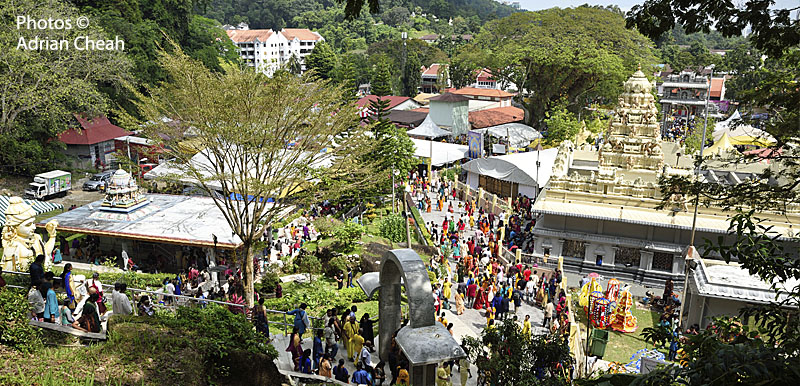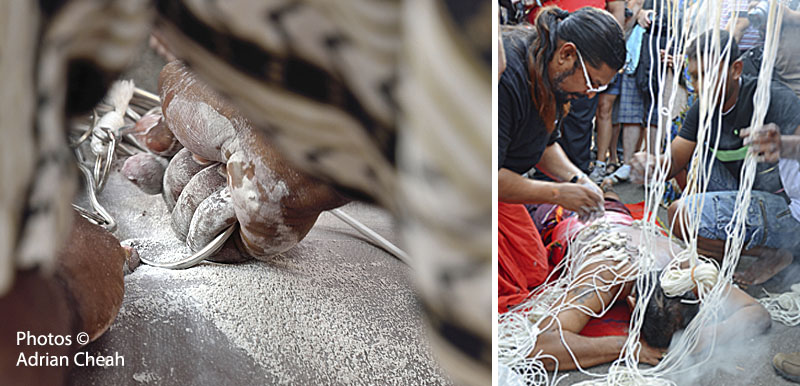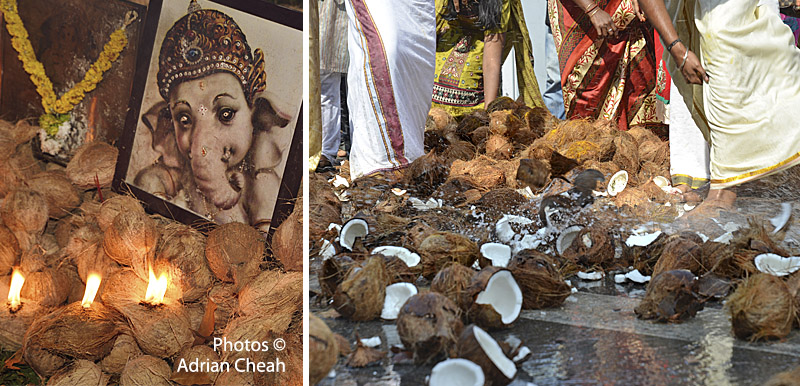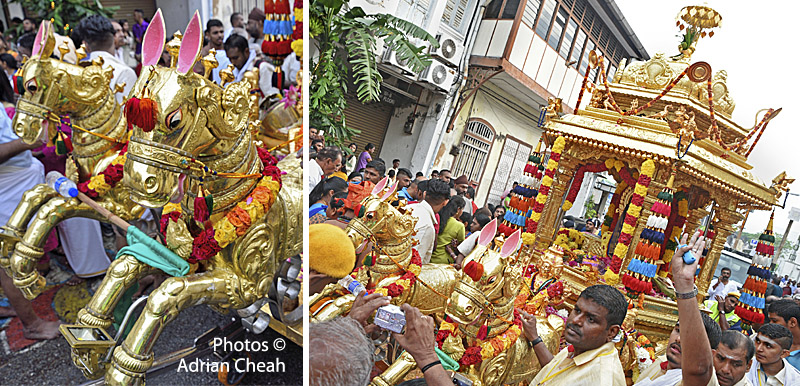On The Crest Of Prayer – The Thaipusam Story

From the top of the green hill, the endless string of devotees dotting its way up the concrete steps seemed like a sacred procession of silence.
Carrying milk-pots of brass and silver, and harnessed in colourful kavadis, the worshippers inched their way to the great temple overhead with sweet hypnotic resolve. The children, the elders, even the disabled ones, scaled slowly with their ceremonial burdens, ascending with a mission to the call of the good Lord Muruga above.

In the temple, Muruga – the protector of the innocent – stood august and majestic in the inner sanctum, arms akimbo. An endless flow of milk cascaded from his crown and down his polished ebony image amid an air wafting with chants, music and heavy sandalwood incense.
Here, in the famous temple atop a small hill in Penang's lush Waterfall suburbia, thousands of devotees end their journey on foot every year. After hours of trekking from the various temples in George Town, the pilgrims ascend the hill with a final inspired spurt of fulfillment and calmness, to release their loads in the holy place as a realisation of their vows.

Hundreds of thousands of devotees and tourists converge at Waterfall every January to celebrate or watch the annual Hindu festival of Thaipusam. The lengthy stretch of road leading to the area, shut completely to traffic, teems with throngs of people who are fringed on both sides by two lines of pandals, or temporary stalls, that provide refreshments, vegetarian food and religious souvenirs.

The Thaipusam tradition was brought to the Malay peninsula through the South Indian diaspora during the 19th century. Ironically, the festival has since evolved and grown so greatly in Malaysia and Singapore that it has now far out-sized celebrations, mostly unheard of, even in India.
In fact, the festivities in Penang have evolved to such an extent that they assimilate distinctly local characteristics that would raise eyebrows in India. For example, the celebrations have drawn a cosmopolitan following of many non-Indians. Groups of Chinese devotees may be seen pulling small chariots of Kuan Yin, the Chinese goddess of mercy. Other groups actually prepare an ornate chariot replete with giant images of Hindu gods such as Shiva and Kali accompanied by the serene image of Kuan Yin.
But in spite of the few inevitable socio-cultural oddities, Thaipusam is by and large inundated with Hindu rites and rituals.

The festival is however popularly known more for the acts of self-impalement by devotees who skewer themselves with hooks and spears as penance. It is unfortunate that such exotic spectacles have prevented many visitors from being more exposed to the profound depths of angelic spirituality many devotees demonstrate.


The early morning of Thaipusam is arguably the finest time for visitors to experience the purist side of the festival. The calm and tranquil march of devotees bearing ceremonial milk-pots, coconuts and simple shoulder-kavadis in the balmy hours is an arresting sight.
Mostly clad in yellow and saffron, with clean-shaven heads smeared with sandalwood paste, the devotees walk along the road sans the boisterousness that dominates the later hours of the day.
The pilgrim procession passes a number of temples along the Waterfall road before the ascent up to the famous hilltop temple. The usually barren rain-gutters along the hillside look like slender white capillaries, flowing down with ceremonial milk offered at the temple above. Further below, a whole river has turned into an amazing canal of milk.

The festivities traditionally end on the evening after Thaipusam day, when the impressive Silver Chariot bearing the image of Muruga, is slowly driven from the Sri Arulmigu Balathandayuthapani Temple in Waterfall on a long overnight journey to the Nattukottai Chettiar Temple in George Town.

The chariot, managed by the Nattukottai Chettiar community, has in fact been earlier brought to the waterfall temple the morning before Thaipusam, in what has become a customary beginning to the festivities.
It is interesting to note that the yearly chariot procession during Thaipusam has been held without fail since 1857. A wooden chariot was used for the first 37 years until the silver chariot was brought from India in 1894; this chariot has been used ever since.
The episode of drawing the chariot back from the Waterfall temple lends an engaging atmosphere of faith, devotion and piety. Hundreds of devotees flock peacefully around the gleaming chariot, carrying trays of offerings – flowers, fruits, betel-leaves, coconuts – amid undulating music of an Indian piper and his drummer.
Little children are lifted up to the idol in the chariot for priests to invoke the deity's blessings; jasmine garlands passed up to be placed on the idol; wisps of incense smoke, the fragrance of rosewater; camera flashes and chants. All these amid a sea of devotion and equanimity.

As the chariot, pulled by bulls, slowly lunges forward, a frenzy of coconut smashing ensues before the sacred deity. Municipal council workers plunge into disciplined action, zooming a pair of bobcats and compactor units to clear the debris as the chariot moves on.

Afar and nigh ahead, the endless peaceful waves of devotees wait patiently to have their glimpses of the sacred idol of Muruga till the holy parade and the festival come again next year.
The Golden Chariot

In 2017, the annual festival had an interesting additional feature. For the first time, Penang witnessed the procession of a golden ‘vel’, the spear used by Lord Muruga to vanquish a great evil demon, on a golden chariot. It plied a couple of hours ahead along the same route as the Silver Chariot. Organised by the state-run Penang Hindu Endowments Board, it was rather interestingly pulled by volunteer devotees, while the Silver Chariot maintained its tradition of being powered by bulls.
---------------------------------------------------------
Thaipusam 2021 amid Covid-19 lockdown
The festival in Penang on 28 January 2021 was canceled for the first time in 164 years. The chariot procession from Little India to Waterfall Road was not supposed to take place. The breaking of coconuts, panthal stalls, distribution of free food, kavadi bearers and paal kudam (milk pot kavadi) during the three-day celebration from 27 to 29 January were also prohibited.
Devotees were advised to offer their prayers at home and were not allowed to go to the temples during Thaipusam.
This decision was made jointly with the Penang Hindu Endowment Board, Unity Department, Health Department, Penang Security Council and police to prevent the spread of Covid-19.
However, the silver chariot left the Kovil Veedu at Penang Street at 3.00 am, after gaining approval from Putrajaya and the police. It was towed by two bulls using a much shorter route to the Nattukotai Chettiar Temple on Jalan Air Terjun. Instead of the previous 6.6 km journey through Jalan Dato Keramat, the chariot journeyed through Hutton Lane and Macalister Road. The silver chariot which carries Lord Muruga arrived at its destination at 5.55 am. According to a report by the Malay Mail, only 10 temple committee members were present throughout the journey and it was done according to strict adherence to standard operating procedures (SOPs).
On 30 January, the return journey of the silver chariot from NattukottaI Chettiar temple began its journey at 1.00 am, arrived safely at the Kovil Veedu temple about an hour and 50 minutes later.
This marked an unbroken tradition, amid the Covid-19 pandemic. The chariot’s owners, the Chettiars had organised the Thaipusam chariot procession for 164 years – 127 years involving the silver chariot and 37 years the wooden chariot donated by the Chettiar Temple in Medan, Indonesia.
Thaipusam 2022
Penang Deputy Chief Minister II, P. Ramasamy, who is also the Penang Hindu Endowment Board (PHEB) chairman, said only the ‘paal kudam’ ritual or carrying the milk pot was permitted without involving any kavadi.
In addition, other ceremonies not allowed during Thaipusam this year include the shaving of heads in temple compounds, coconut-breaking, setting up of stalls and free food distribution (thaneer panthal).
He said the decision was reached after the Penang government held a meeting with National Unity Minister Datuk Halimah Mohamed Sadique on Thursday, 6 January 2022.
Thaipusam 2023
In 2023, the Thaipusam celebrations in Penang was back with a vibrant spirit, bringing the festivities into full swing!
---------------------------------------------------------
Written by Himanshu Bhatt © All rights reserved
Photographed by Adrian Cheah © All rights reserved
Updated 21 January 2024